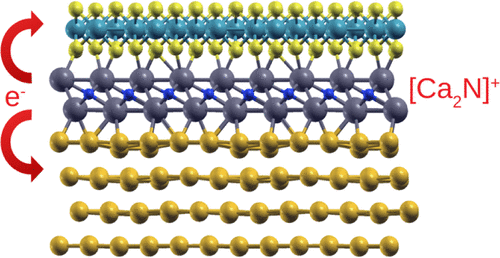当前位置:
X-MOL 学术
›
J. Phys. Chem. C
›
论文详情
Our official English website, www.x-mol.net, welcomes your
feedback! (Note: you will need to create a separate account there.)
Improved Charge Transfer and Barrier Lowering across a Au–MoS2 Interface through Insertion of a Layered Ca2N Electride
The Journal of Physical Chemistry C ( IF 3.3 ) Pub Date : 2021-05-21 , DOI: 10.1021/acs.jpcc.1c02142 Fouad Kaadou 1 , Jesse Maassen 1 , Erin R. Johnson 2
The Journal of Physical Chemistry C ( IF 3.3 ) Pub Date : 2021-05-21 , DOI: 10.1021/acs.jpcc.1c02142 Fouad Kaadou 1 , Jesse Maassen 1 , Erin R. Johnson 2
Affiliation

|
Despite immense promise, use of transition-metal dichalcogenides (TMDCs), such as MoS2, in electronics applications is hindered by the difficulties in forming effective metal contacts with low resistance. In this work, we propose insertion of a two-dimensional (2D) electride [Ca2N]+(e–) at a metal–TMDC interface to establish proper electrical contact. As a proof of concept, we consider the Au–MoS2 interface due to the presence of a van der Waals gap, which leads to a high tunneling barrier and strong Fermi-level pinning. Density-functional theory calculations predict nearly complete charge transfer from the electride surface states, resulting in a cationic [Ca2N]+ monolayer at the interface and metalization of the negatively doped MoS2. Thus, formation of the Au–Ca2N–MoS2 heterostructure eliminates both the tunneling and Schottky barriers, indicating that inserting a single 2D electride layer at metal–TMDC interfaces is a viable strategy to achieve proper Ohmic contacts in device manufacture.
中文翻译:

通过插入层状 Ca 2 N 电极改善 Au-MoS 2界面的电荷转移和势垒降低
尽管前景广阔,但过渡金属二硫属化物 (TMDC)(例如 MoS 2)在电子应用中的应用由于难以形成低电阻的有效金属接触而受到阻碍。在这项工作中,我们建议在金属-TMDC 界面插入二维 (2D) 电子化合物 [Ca 2 N] + (e – ) 以建立适当的电接触。作为概念证明,我们考虑了 Au-MoS 2界面,因为存在范德华间隙,这导致高隧道势垒和强费米能级钉扎。密度泛函理论计算预测从电子表面状态几乎完全的电荷转移,导致阳离子 [Ca 2 N] +单层在负掺杂的 MoS 2的界面和金属化。因此,Au-Ca 2 N-MoS 2异质结构的形成消除了隧道势垒和肖特基势垒,表明在金属-TMDC 界面处插入单个二维电子层是在器件制造中实现适当欧姆接触的可行策略。
更新日期:2021-06-03
中文翻译:

通过插入层状 Ca 2 N 电极改善 Au-MoS 2界面的电荷转移和势垒降低
尽管前景广阔,但过渡金属二硫属化物 (TMDC)(例如 MoS 2)在电子应用中的应用由于难以形成低电阻的有效金属接触而受到阻碍。在这项工作中,我们建议在金属-TMDC 界面插入二维 (2D) 电子化合物 [Ca 2 N] + (e – ) 以建立适当的电接触。作为概念证明,我们考虑了 Au-MoS 2界面,因为存在范德华间隙,这导致高隧道势垒和强费米能级钉扎。密度泛函理论计算预测从电子表面状态几乎完全的电荷转移,导致阳离子 [Ca 2 N] +单层在负掺杂的 MoS 2的界面和金属化。因此,Au-Ca 2 N-MoS 2异质结构的形成消除了隧道势垒和肖特基势垒,表明在金属-TMDC 界面处插入单个二维电子层是在器件制造中实现适当欧姆接触的可行策略。





















































 京公网安备 11010802027423号
京公网安备 11010802027423号